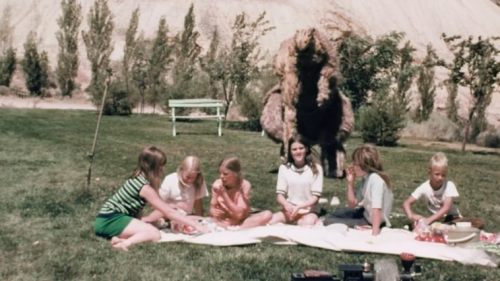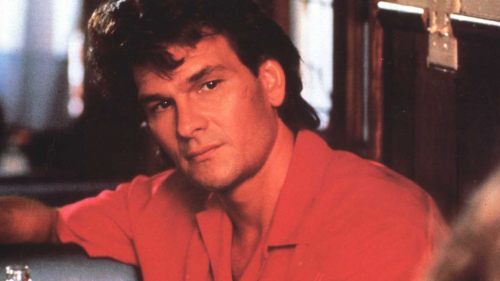Everybody’s Into Weirdness: Skatetown USA (1979)
The Alamo Drafthouse is a brand built on weird. Beyond being situated in a town that has long aspired to remain eccentric in the face of all normality, it’s easy to forget that the original Alamo started as something of a private screening club, running prints of the odd and obscure into all hours of the night*. Though the company has obviously grown into an internationally recognized chain of first run movie palaces, the Drafthouse Ritz in Austin, Texas, remains committed to showcasing genre repertory programming, namely via its Terror Tuesday and Weird Wednesday showcases. This column is a concentrated effort to keep that spirit of strangeness alive, as programmers Joe A. Ziemba and Laird Jimenez (often pulling from the extensive AGFA archives) are truly doing Satan’s bidding by bringing ATX weekly doses of delightful trash art.
The second entry into this disreputable canon is Patrick Swayze’s first motion picture, the roller boogie extravaganza, Skatetown USA (1979)...
Year: 1979
Trailers: Roller Boogie; Disco Fever
The legend regarding the moment of conception for Brian De Palma’s Phantom of the Paradise involves the young director, frustrated with Hollywood’s inability to greenlight any of his original pitches, riding in an elevator and hearing a Muzak version of a Beatles song. De Palma became so furious with the idea of rock and roll being watered down and utilized by a corporation for their own “easy listening” purposes that he set out to make a movie that captured the music’s rebellious spirit. In essence, Phantom of the Paradise was meant to be a flaming fist of “fuck you,” a middle finger to any suit who thought they could harness the essence of artistic expression and use it to sell whatever commodity they deemed worthy that week.
Skatetown USA is the opposite of that purposeful defiance; a cash-in that combined one dying sensation (disco) with another (roller skating) that was currently overtaking California’s pop culture landscape. In the mid-to-late '70s, over 4,000 roller discotheques** opened across the country (including Hollywood’s fleetingly famous Flipper’s Roller Boogie Palace, on which the picture is based), bathing freewheeling, cocaine-imbibing patrons with neon light and thumping, cowbell-accented bass. Just as they’d done throughout history, Hollywood producers saw this boom and decided to capitalize on it with a “what the kids want these days” mentality, motivated solely by dollar signs. This audacious attitude adds a rather pure sense of exploitation to Skatetown USA that makes it feel both incredibly authentic and wholly manufactured. It’s the end product of unimaginative men with money seeing a bunch of people getting rich off of youthful joy and not wanting to be cut out of the action, while simultaneously creating a Tiger Beat time capsule.
Keeping this impetus in mind, it makes sense that the first roller disco motion picture would come from writer/director/all-around huckster William A. Levey. Levey was an exploitation lifer, beginning his career with the 1973 Blaxploitation creature feature, Blackenstein. His bizarro career would continue with the impregnating aliens bit of batshit, Wham! Bam! Thank You Spaceman! in 1975, followed by his work on the middle entry in Cannon Films’ Happy Hooker trilogy, The Happy Hooker Goes to Washington. Don’t let the logo before Skatetown USA fool you; while Columbia Pictures distributed Levey’s dancehall slice of insanity, the film is still entrenched in the grimy grindhouse culture he was most familiar with. The director’s camera may capture all of the fluid party set pieces with ease, but it also doesn’t miss an opportunity to leer at barely covered breasts or polyester short shorts. For lovers of feathered hair and bubblegum-popping blondes, Skatetown USA can double as PG-rated softcore.
Exploitation aside, Skatetown USA is also an incredibly funny and sincere slice of sleaze. Levey fills each and every frame with an overwhelming amount of information. There’s a ZAZ sensibility to the comedy on display – complete reckless abandon as Levey throws as many jokes at the wall as he can, knowing that more than a few will probably stick. All of the actors are completely game and lacking any semblance of shame, including the colorful array of side players. Bill Kirchenbauer (Coach from Growing Pains and Clueless) stumbles around set, groping women with a doctor’s head mirror on whilst screaming about flashbacks to his time in a war simulation. Mannig the booth is The Wizard (Denny Johnston), a record spinning DJ with a giant sparkling afro who also shoots magic lightning from his fingers. Possibly the weirdest cameo is centerfold Dorothy Stratten*** as an unnamed snack bar patron who is hit on by an elderly lounge lizard comedian with an arsenal of one-liners. It all adds up to a buzzed, celebratory vibe the movie confidently owns.
Unfortunately, many of the movie’s main stars do not look back on this hedonistic hell on wheels with much fondness. Maureen McCormick (a/k/a Marsha Brady from The Brady Bunch) attributes the movie’s production to helping rekindle her love affair with cocaine (which is readily apparent in hindsight, as she’s radiant, glass-eyed and constantly jawing). In her memoir, Here’s the Story: Surviving Marsha Brady and Finding My True Voice, McCormick recalls the set being “more like a party,” and that blow was simply being done out in the open. Patrick Swayze (who, in his first screen role, plays Ace -- the leader of a roller skate gang known as the Westside Wheelers) barely acknowledged the movie existed while he was still alive. Talking to AV Club’s Will Harris (for Harris’ excellent “Random Roles” column), Scott Baio (who is really only passively in the movie as a hero’s sidekick) bashed Skatetown USA into oblivion:
I have blocked that movie from my memory. It was so bad. That was that whole time where Xanadu and Roller Boogie and all that crap was coming out. That was one of those things where they sent me the script and I said “no,” but they just kept calling and offering more money! I mean, they offered me a lot of money. And finally I said,“Well, hell. What is it? Two weeks’ work? Whatever, okay, fine.” You know, sometimes money isn’t everything. It was just a guy making a film who didn’t know how to make a film. Skatetown, USA, that was crapola.
Strong words coming from Scott Baio. None other than Nick Castle, good friend of John Carpenter’s, penned the script he kept sending back. Castle had one of the strangest careers in Hollywood, playing not only a slasher icon in Carpenter’s classic (he was the original Shape in Halloween), but also writing Escape From New York for the genre legend. While he would go on to direct his own films (including 1984’s The Last Starfighter), one can’t help but imagine his work on Skatetown USA being anything more than scene sketching around endless dance set pieces. To try and describe the plot of this movie is a fool’s errand (there’s a disco competition worth a whopping $1000 and a Romeo & Juliet-style subplot), as most of the movie is just bizarre synchronized breakdowns. None of this is a knock, mind you; just an observation on how easy it must’ve been to leave every other page blank with the words “DANCE OFF” bolded in the very middle.
Though out of all the commentaries on this picture that would be interesting to hear, it’s a shame Rich Palillo (a/k/a Horshack from Welcome Back Kotter) is no longer with us to share what must’ve been one hell of a warped experience. His right hand man to Swayze’s Ace is a bizarre, flamboyant insane person that’s played like Tony Manero as an escaped, dog-collared death row inmate. It’s a completely nutso performance that hangs on the perimeter for most of the movie’s runtime, only to be let loose in the back half when he and Marsha Brady get to share a slice of pill-laced pizza (don’t ask). Palillo has a completely otherworldly energy in the picture, injecting every scene with a cartoonish menacing presence. It’s great fun, and a testament to what a weird, often overlooked talent Palillo was.
Even if milking pop culture for all its worth is the central inspiration behind the film’s inception, that doesn’t stop it from being one hell of a shindig. It’s safe to say that Skatetown USA only plays in a communal sense; shared with a group of like-minded folks ready to let themselves be transported back to mirror balls, big hair and reverberating wah wah pedal effects. You don’t watch a movie like this so much as you experience it. Skatetown USA wouldn’t work in a living room. Hearing the film’s stellar soundtrack (the rights to which are undoubtedly one of the reasons it's never been available on home video) and watching a crowd react to needle drops from the likes of Earth, Wind and Fire and The Jacksons is something special. Suddenly, you can smell the cheap booze and hairspray while the skates hitting the hardwood cause a cacophonous clacking that keeps time with the beat. So the next time you wanna have a good time, there’s only one destination to keep in mind. Fuck Xanadu – head to Skatetown USA.
*For an oral history of the Drafthouse’s beginnings, I’ll refer you to Zack McGhee’s wonderful “My Favorite Movie” Podcast, where he interviews old school DH programmers Lars Nilsen and Zack Carlson, as well as current Wednesday night ringmaster, Laird Jimenez. They’re GREAT listens, full of knowledge, wit and insight.
**Pre-Show Side Note: Throughout the digitally projected montage that plays during seating, the three vivacious women sitting next to me were able to name every single roller derby track from the trailers. It was INCREDIBLE.
***In only the second of four big screen appearances the doomed Playboy Playmate would make before being brutally murdered by obsessive boyfriend Paul Snider (who would be the subject of Eric Roberts’ best work in Bob Fosse’s Star 80).
Tonight at Weird Wednesday: Blood Games.



